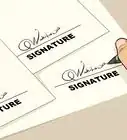This article was co-authored by Courtney Copriviza and by wikiHow staff writer, Devin McSween. Courtney Copriviza is an Elementary School Teacher based in Maui, HI. Courtney specializes in elementary education, classroom management, and social and emotional development. She holds a BA in Communication with a minor in Urban Education and an MA in Teaching from Santa Clara University. Courtney has also taught high school in Madrid, Spain. She is a member of Kappa Delta Pi International Honors Society in Education.
There are 7 references cited in this article, which can be found at the bottom of the page.
wikiHow marks an article as reader-approved once it receives enough positive feedback. This article has 42 testimonials from our readers, earning it our reader-approved status.
This article has been viewed 3,913,956 times.
We’ve all been there: you’re reviewing your lecture notes but can’t seem to make out your words as they run together and tilt off the page. It would be great if you didn’t have to decode your own writing, so is there any way you can make it better? Whether you’re trying to reign in unruly letters or get back your handwriting flair from years ago, we’ll show you the techniques to use to improve your handwriting. Read on to learn how!
Things You Should Know
- Find handwriting inspiration online to develop your handwriting style. Copy your favorite letters to incorporate them into your writing.
- Write out the alphabet to make your letters consistent. Then, practice writing full sentences.
- Hand write things every chance you get. Write out work to-dos, school notes, start a journal, and send letters to friends.
Steps
Analyzing Your Handwriting
-
1Write a paragraph. Choose a topic that you enjoy and write at least five sentences about it. If you’re not feeling too creative, simply copy a passage out of a book or newspaper. The goal is to get a general idea of what your handwriting looks like in your day-to-day life. The more you write, the more accurate your analysis will be.[1]
-
2Identify the primary shapes of your letters. Seeing what type of lines you tend to make can help you figure out your handwriting style. Are your letters full of loops and curves? Do you primarily make stiff, straight lines? Or maybe your letters all have hard corners and tend to blend together.Advertisement
-
3Look for a slant to your letters. The angle at which you write your letters can change the look of your handwriting. Is your handwriting perpendicular to the lines under it? Does it fall to the left or to the right significantly? It’s okay to have a slight slant, but too much of one can make reading your writing difficult.
-
4Check the alignment of your words on the lines of your paper. Generally, handwriting is the easiest to read when your words are written flush against the lines of the page. Do your letters tend to slant upwards or downwards on your paper? Do they overlap with the lines on the page? Then, check if your alignment is consistent, too. Is every word individually angled, or do entire lines of text head in a similar direction away from the line?
-
5Look at the spacing between your words and letters. A good guide to follow is to make enough space to fit the letter “O” between each word. Using more or less space than this can change how easy it is to read your handwriting. Pay attention to the closeness of each individual letter, too. Your letters shouldn’t be so far apart that you don’t know what word they belong to, but not so squished together that they run into each other.
-
6Pay attention to the size of your letters on your paper. You might find that your writing easily fills up 2 full lines. Or, you tend to write all your words cramped under the middle of a single line. Whatever size you generally write in, it needs to be legible to you.
- Look at the size of your letters in relation to each other, too. Capital letters should be larger than lowercase ones, while tall letters like “t” should extend past small letters like “a.”
-
7Analyze the pressure you use when you write. Look at how you indent the page with your pen or pencil. Are the lines of your letters thick and dark, or are they faint and hard to read? Check how your pen or pencil moves across the page, too. Are your lines straight and sure, or are they kind of squiggly and uneven?
-
8Determine the areas that you want to improve. Looking at how you tend to shape, slant, space, and align your letters, think about what you like and what you want to improve about your handwriting. You might love how you round and curve your letters, but want to straighten them against the page so they’re more legible. Or, there might be a letter that always comes out misshapen that you want to perfect. Honing in on certain areas tells you what you need to practice.[2]
-
9Look at other handwriting styles to get inspiration. Now that you know what you want to improve about your writing, look up fonts and handwriting samples online to develop your own style. If there’s a certain flourish you like or the way a font writes the letter “y,” copy the style on a piece of paper.[3]
- You don’t have to adopt an entirely new style or copy someone else’s word for word. Just pick and choose certain aspects of different styles to incorporate the shapes and letters into your writing and make them your own.
Changing Your Handwriting
-
1Write in the air. Writing involves your hand, arm, and shoulder muscles. So, to write neatly and consistently, you need to train and develop them. To work out your writing muscles, write sentences in the air using your finger. This forces you to use the muscle groups in your arm and shoulder that help stabilize your hand and improve the shape and form of your letters.[4]
-
2Find a comfortable grip on your pen or pencil. A firm yet relaxed grip can prevent your hand from cramping and help your letters come out neater. Find a comfortable grip by holding your pen or pencil between your thumb and index finger about ⅓ of the way from the tip. Then, use your other fingers to support the pen and your index finger. Let the end of the writing utensil rest against either the web of your hand or against the knuckle of your index finger.[5]
- Your general posture can help improve your writing, too. Wiggle your wrist to loosen it and relax your shoulders as you write.
-
3Practice basic letter shapes. All of the letters in the alphabet are made up of straight lines, circles, and semi-circles, so take time to draw out these shapes. Fill an entire sheet of paper with parallel vertical lines and parallel diagonal lines. Then, do the same with a sheet of “o” and “c” shapes as well. Practice your loops and squiggles too, which form the letters “e” and “s.” Making the same lines and shapes over and over helps your letters come out regular and consistent.[6]
-
4Study a directional chart. When you were first learning to write in kindergarten, you likely used a directional chart to learn the correct way to form your letters. Going back to the basics can help you nail down your letters and keep them consistent as you write. So, just follow one of these guidelines and fill up a sheet with the correct downwards and upwards strokes. For example, rather than starting a lowercase ‘a’ with the tail, begin at the top of the loop.
-
5Experiment with different writing utensils to find what works for you. Pens and pencils aren’t one-size fits all. Different sizes and styles might fit in your hand more comfortably, which can change how you write. Choose a pen based on how you like the flow of ink as you write; some pens to try are ballpoint, roll-on, and felt tip. Or, see if you prefer the movement of a traditional or mechanical pencil.[7]
- When you find the type of pen or pencil you like, experiment with different lead sizes and pen tips to find what thickness makes your handwriting pop, too.
-
6Practice your alphabet. Yes, just like in first grade, fill up a piece of paper with each letter of the alphabet in lower and uppercase. Use your font inspiration and your handwriting analysis to focus on what you want to change about your letters. If you want to improve your slanting, practice making your letters vertical. If you’re changing the style of your letters, concentrate on simulating the shapes you see in your handwriting inspiration.[8]
-
7Practice writing sentences. Once you’ve nailed the shapes of your letters, write them into full words and sentences. To practice using all of the letters of the alphabet at once, write the phrase “The quick brown fox jumps over the lazy dog” over and over again. The adage “Practice makes perfect” certainly applies here, so be patient with your progress. It can take days to weeks to see improvement in your writing.
- If writing the same phrase over again gets tiring, write down some of your favorite quotes and song lyrics, or practice your own name.
-
8Handwrite things whenever you can. Instead of typing up your essay outline or sending an email to a friend, write your homework or a letter by hand. Writing things whenever it’s possible is the best way to practice and improve your handwriting. It might take a bit longer than typing, but you’ll help build up the muscles that are necessary for easy, smooth, and neat handwriting.[9]
- To practice your writing every day, start a journal, make your to-do lists by hand, or complete handwriting practice sheets.
Community Q&A
-
QuestionWhy should you look at different styles if you are already having trouble with your own handwriting?
 wikiHow Staff EditorThis answer was written by one of our trained team of researchers who validated it for accuracy and comprehensiveness.
wikiHow Staff EditorThis answer was written by one of our trained team of researchers who validated it for accuracy and comprehensiveness.
Staff Answer wikiHow Staff EditorStaff AnswerLooking at different handwriting styles can inspire you to improve and help you develop your own style. As you practice making your letters and style more consistent, you can use your inspiration as a guide to help you form your letters.
wikiHow Staff EditorStaff AnswerLooking at different handwriting styles can inspire you to improve and help you develop your own style. As you practice making your letters and style more consistent, you can use your inspiration as a guide to help you form your letters. -
QuestionIs it better to write with a pen or a pencil?
 wikiHow Staff EditorThis answer was written by one of our trained team of researchers who validated it for accuracy and comprehensiveness.
wikiHow Staff EditorThis answer was written by one of our trained team of researchers who validated it for accuracy and comprehensiveness.
Staff Answer wikiHow Staff EditorStaff AnswerUsing a pen or pencil just comes down to your preference; one isn't better than the other. Try out different kinds of leads and pen tips to see what looks and feels the best to you.
wikiHow Staff EditorStaff AnswerUsing a pen or pencil just comes down to your preference; one isn't better than the other. Try out different kinds of leads and pen tips to see what looks and feels the best to you. -
QuestionHow can I learn to write fast and neatly in exams?
 Community AnswerPractice a lot, and you will get better. If you practice writing slowly, then increase the speed, it'll soon become your normal approach.
Community AnswerPractice a lot, and you will get better. If you practice writing slowly, then increase the speed, it'll soon become your normal approach.
Handwriting Practice Page
Warnings
- Don't press the nib, or tip, of your pen hard on the paper as you write. Pressing down hard can cause your hand to cramp, so keep your pressure even.⧼thumbs_response⧽
- Reuse your practice sheets and paper as much as you can to prevent excess waste. Use the front and back of each sheet and write in the margins.⧼thumbs_response⧽
- To prevent writer's cramp, use your wrist and arm to support your hand. Then, relax your grip on your pen or pencil.⧼thumbs_response⧽
- Don't throw away your templates or practice sheets. Use these as guidelines as you write to see how the letters should look and what you need to improve.⧼thumbs_response⧽
References
- ↑ https://www.popsci.com/diy/how-to-improve-handwriting/
- ↑ https://realtytimes.com/agentnews/agentadvice/item/8744-20060406_handwriting
- ↑ https://www.popsci.com/diy/how-to-improve-handwriting/
- ↑ https://www.businessinsider.com/tips-to-improve-handwriting-2014-7
- ↑ https://www.nhsggc.org.uk/kids/resources/ot-activityinformation-sheets/holding-a-pencil/
- ↑ https://masgrimes.com/journal/how-to-improve-your-handwriting
- ↑ https://www.businessinsider.com/tips-to-improve-handwriting-2014-7
- ↑ https://www.popsci.com/diy/how-to-improve-handwriting/
- ↑ https://pubmed.ncbi.nlm.nih.gov/21395194/
- Videos provided by Katie Angel
About This Article
To get better handwriting, write so there's enough space between each of your words to fit an imaginary letter "O," and make sure you're writing your letters straight, not slanted. Practice writing with smooth, even lines instead of lines that are squiggly and uneven. Write every day, and handwrite your notes whenever you get a chance so you can keep improving. To learn about how to fix slants and get better line quality while you write, keep reading the article!
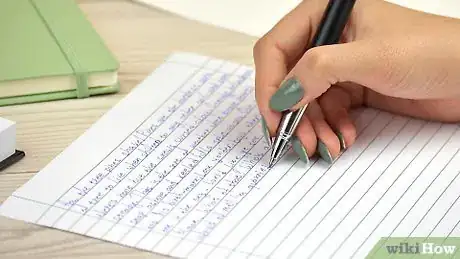






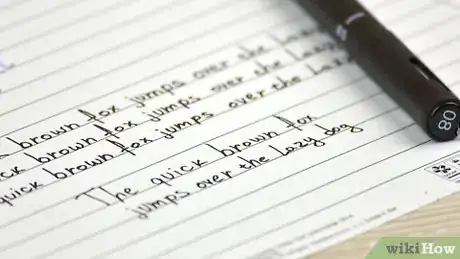
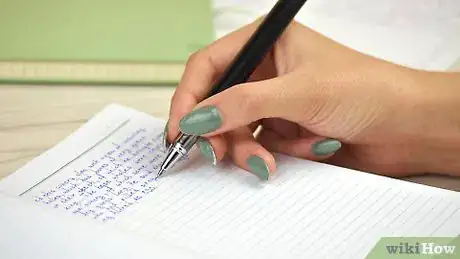

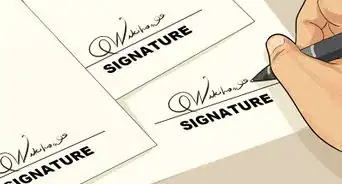



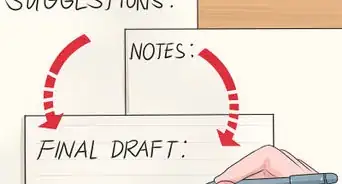
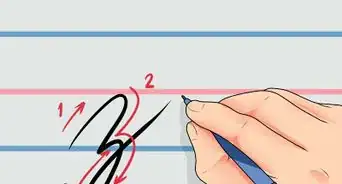



-Step-11-Version-3.webp)















